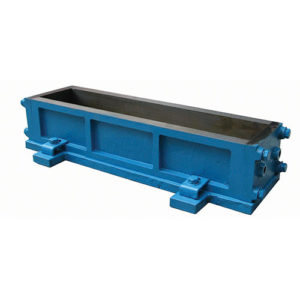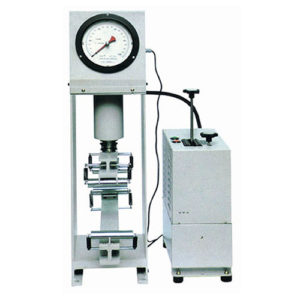Flexural Strength Test Of Concrete and How to Perform It
Posted on March 25, 2019
Flexural Strength Test is used to evaluate the tensile strength of the concrete in an indirect way. It tests the capacity of the slab or unreinforced concrete beam to endure bending failure.
The outcome of the flexural test on the concrete are demonstrated as a modulus rupture which is signified as (MR) in MPa psi.Flexure Strength Testing Machine for concrete Equipment and Apparatuses
Beam Mould equivalent to the size of 15 x 15x 70 cm or to the size of 10 x 10 x 50 cm. Tamping bar of 2kg and 40 cm long along with a tamping section measuring 25 mm x 25 mm Flexural testmachine – The Flexure Strength Testing Machine for concrete surface or bed should be equipped with two steel rollers, with each of them having a diameter of 38 mm. The bed should support the specimen while the rollers shall be mounted in order to maintain the distance from centre to centre is 60 cm for 15.0 cm specimens or 40 cm for 10.0 cm specimens. Also, using the two similar rollers that support the span at a distance of 20 or 13.3 cm centre to centre the load shall be applied. Moreover, the load should be distributed proportionately between the two loading rollers. Also, all the rollers should be arranged in such a way that the load is exerted without having the specimen go through any sort of restraint or torsional stress.
Flexural testmachine – The Flexure Strength Testing Machine for concrete surface or bed should be equipped with two steel rollers, with each of them having a diameter of 38 mm. The bed should support the specimen while the rollers shall be mounted in order to maintain the distance from centre to centre is 60 cm for 15.0 cm specimens or 40 cm for 10.0 cm specimens. Also, using the two similar rollers that support the span at a distance of 20 or 13.3 cm centre to centre the load shall be applied. Moreover, the load should be distributed proportionately between the two loading rollers. Also, all the rollers should be arranged in such a way that the load is exerted without having the specimen go through any sort of restraint or torsional stress.
 Procedure
Prepare the sample of the test by filling the concrete in equal thickness in 3 layers. Now by using the tamping, tamp each layer approximate 35 times. Make sure to disburse the tamping in equal proportion across the whole crossection of the beam and within each layer of the depth.
The second step is to clean the surface of the bearing loading and supporting rollers. Also, get rid of any loose sand or different material off the surface area of the sample where they would come in contact with the rollers.
Use circular rollers to provide support and load points into the specimens. The rollers should be at least 10 mm more than the width of the test sample. Make sure to use a total of 4 rollers, with 3 of them should be equipped to rotate within their own axes.
The water stored sample should be made to test immediately once it is removed from water. The specimen should be placed in the machine in a proper way with longitudinal axis of the sample facing the right angle to that of rollers.
The load shall be exerted @ of loading of 400 kg/min probably for the 15.0 cm specimen and at a cost of 180 kg/min for the 10.0 cm.
Procedure
Prepare the sample of the test by filling the concrete in equal thickness in 3 layers. Now by using the tamping, tamp each layer approximate 35 times. Make sure to disburse the tamping in equal proportion across the whole crossection of the beam and within each layer of the depth.
The second step is to clean the surface of the bearing loading and supporting rollers. Also, get rid of any loose sand or different material off the surface area of the sample where they would come in contact with the rollers.
Use circular rollers to provide support and load points into the specimens. The rollers should be at least 10 mm more than the width of the test sample. Make sure to use a total of 4 rollers, with 3 of them should be equipped to rotate within their own axes.
The water stored sample should be made to test immediately once it is removed from water. The specimen should be placed in the machine in a proper way with longitudinal axis of the sample facing the right angle to that of rollers.
The load shall be exerted @ of loading of 400 kg/min probably for the 15.0 cm specimen and at a cost of 180 kg/min for the 10.0 cm.
 Calculation
The Flexural Strength or modulus of rupture (fb) is given as following
fb = pl/bd2 (when a > 20.0cm for 15.0cm specimen or and 13.0cm for 10cm specimen)
or
fb = 3pa/bd2 (when a and 20.0cm but and 17.0 for 15.0cm specimen or < 13.3 cm but and 11.0cm for 10.0cm specimen.)
Where,
Calculation
The Flexural Strength or modulus of rupture (fb) is given as following
fb = pl/bd2 (when a > 20.0cm for 15.0cm specimen or and 13.0cm for 10cm specimen)
or
fb = 3pa/bd2 (when a and 20.0cm but and 17.0 for 15.0cm specimen or < 13.3 cm but and 11.0cm for 10.0cm specimen.)
Where,
- a = denotes distance in between the line of fracture and the nearer support, gauged on the center line of the tensile side of the sample
- b = specimen width (cm)
- d = failure point depth (cm)
- l = supported length (cm)
- p = max. Load (kg)
- Hand gloves and safety shoes to be used while performing the test
- Switch off the machine post the test
- Make sure to keep the internally exposed tools of the mould greased
- Place the guide rods in a fixed position
- Always ensure to clean the equipment extensively prior and post the testing
Written by:- for Concrete
